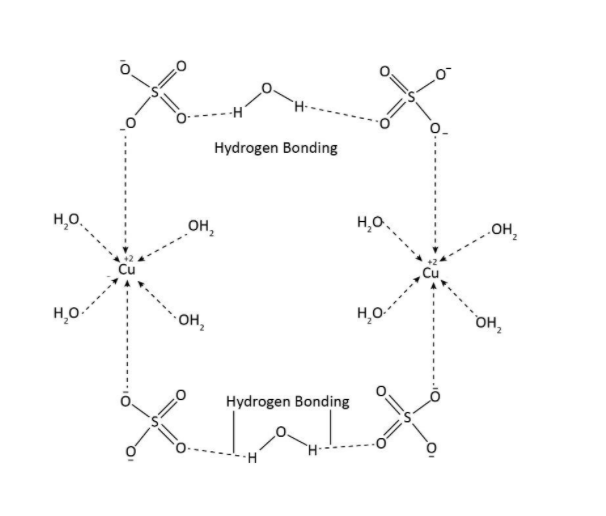
${\rm{CuS}}{{\rm{O}}_{\rm{4}}}{\rm{.5}}{{\rm{H}}_{\rm{2}}}{\rm{O}}$ is represented as:
A. $\left[ {{\rm{Cu}}{{\left( {{{\rm{H}}_{\rm{2}}}{\rm{O}}} \right)}_4}} \right]{\rm{S}}{{\rm{O}}_{\rm{4}}}$
B. \[\left[ {{\rm{Cu}}{{\left( {{{\rm{H}}_{\rm{2}}}{\rm{O}}} \right)}_3}{\rm{S}}{{\rm{O}}_{\rm{4}}}} \right]{\rm{.2}}{{\rm{H}}_{\rm{2}}}{\rm{O}}\]
C. \[\left[ {{\rm{Cu}}{{\left( {{{\rm{H}}_{\rm{2}}}{\rm{O}}} \right)}_4}{\rm{S}}{{\rm{O}}_{\rm{4}}}} \right].{{\rm{H}}_{\rm{2}}}{\rm{O}}\]
D. \[\left[ {{\rm{Cu}}{{\left( {{{\rm{H}}_{\rm{2}}}{\rm{O}}} \right)}_5}{\rm{S}}{{\rm{O}}_{\rm{4}}}} \right]\]
Answer
572.1k+ views
Hint: We know that, the chemical name of ${\rm{CuS}}{{\rm{O}}_{\rm{4}}}{\rm{.5}}{{\rm{H}}_{\rm{2}}}{\rm{O}}$ compound is copper sulfate pentahydrate. The central metal atom ${\rm{Cu}}$ is in $ + 2$ oxidation state and it is directly linked to four molecules of water in this complex.
Complete step by step answer:
We know that, ${\rm{CuS}}{{\rm{O}}_{\rm{4}}}{\rm{.5}}{{\rm{H}}_{\rm{2}}}{\rm{O}}$ is copper sulfate pentahydrate. It is an inorganic compound. It is a blue colored crystal which is soluble in water. In the structure of ${\rm{CuS}}{{\rm{O}}_{\rm{4}}}{\rm{.5}}{{\rm{H}}_{\rm{2}}}{\rm{O}}$, four molecules of water are directly attached to the central atom copper and one molecule of water is present as water of crystallization. Therefore, we conclude that ${\rm{CuS}}{{\rm{O}}_{\rm{4}}}{\rm{.5}}{{\rm{H}}_{\rm{2}}}{\rm{O}}$ is also represented as \[\left[ {{\rm{Cu}}{{\left( {{{\rm{H}}_{\rm{2}}}{\rm{O}}} \right)}_4}{\rm{S}}{{\rm{O}}_{\rm{4}}}} \right].{{\rm{H}}_{\rm{2}}}{\rm{O}}\]. The structure of this complex is shown below.

So as we can see, it is clear from the structure that the central metal atom copper is bonded to four water molecules and the remaining fifth water molecule is bonded to sulfate anion through hydrogen bonding (it is already known that the hydrogen bonding is specifically for those atoms which have hydrogen attached to electronegative atom such as oxygen, fluorine and nitrogen).
Hence, we can say that, ${\rm{CuS}}{{\rm{O}}_{\rm{4}}}{\rm{.5}}{{\rm{H}}_{\rm{2}}}{\rm{O}}$ is represented as \[\left[ {{\rm{Cu}}{{\left( {{{\rm{H}}_{\rm{2}}}{\rm{O}}} \right)}_4}{\rm{S}}{{\rm{O}}_{\rm{4}}}} \right].{{\rm{H}}_{\rm{2}}}{\rm{O}}\].
Thus, the correct option is C.
Note:
As we know that, the inorganic compound ${\rm{CuS}}{{\rm{O}}_{\rm{4}}}{\rm{.5}}{{\rm{H}}_{\rm{2}}}{\rm{O}}$, is a pentahydrate. There are other common names for this compound, which consists of bluestone, blue vitriol, roman vitriol, etc. This complex on dissolution in water gives an aqua complex having chemical formula ${\left[ {{\rm{Cu}}{{\left( {{{\rm{H}}_{\rm{2}}}{\rm{O}}} \right)}_6}} \right]^{2 + }}$. It has an octahedral geometry. In \[\left[ {{\rm{Cu}}{{\left( {{{\rm{H}}_{\rm{2}}}{\rm{O}}} \right)}_4}{\rm{S}}{{\rm{O}}_{\rm{4}}}} \right].{{\rm{H}}_{\rm{2}}}{\rm{O}}\], the centres are interconnected through sulfate ions and thus they form chains.
Complete step by step answer:
We know that, ${\rm{CuS}}{{\rm{O}}_{\rm{4}}}{\rm{.5}}{{\rm{H}}_{\rm{2}}}{\rm{O}}$ is copper sulfate pentahydrate. It is an inorganic compound. It is a blue colored crystal which is soluble in water. In the structure of ${\rm{CuS}}{{\rm{O}}_{\rm{4}}}{\rm{.5}}{{\rm{H}}_{\rm{2}}}{\rm{O}}$, four molecules of water are directly attached to the central atom copper and one molecule of water is present as water of crystallization. Therefore, we conclude that ${\rm{CuS}}{{\rm{O}}_{\rm{4}}}{\rm{.5}}{{\rm{H}}_{\rm{2}}}{\rm{O}}$ is also represented as \[\left[ {{\rm{Cu}}{{\left( {{{\rm{H}}_{\rm{2}}}{\rm{O}}} \right)}_4}{\rm{S}}{{\rm{O}}_{\rm{4}}}} \right].{{\rm{H}}_{\rm{2}}}{\rm{O}}\]. The structure of this complex is shown below.

So as we can see, it is clear from the structure that the central metal atom copper is bonded to four water molecules and the remaining fifth water molecule is bonded to sulfate anion through hydrogen bonding (it is already known that the hydrogen bonding is specifically for those atoms which have hydrogen attached to electronegative atom such as oxygen, fluorine and nitrogen).
Hence, we can say that, ${\rm{CuS}}{{\rm{O}}_{\rm{4}}}{\rm{.5}}{{\rm{H}}_{\rm{2}}}{\rm{O}}$ is represented as \[\left[ {{\rm{Cu}}{{\left( {{{\rm{H}}_{\rm{2}}}{\rm{O}}} \right)}_4}{\rm{S}}{{\rm{O}}_{\rm{4}}}} \right].{{\rm{H}}_{\rm{2}}}{\rm{O}}\].
Thus, the correct option is C.
Note:
As we know that, the inorganic compound ${\rm{CuS}}{{\rm{O}}_{\rm{4}}}{\rm{.5}}{{\rm{H}}_{\rm{2}}}{\rm{O}}$, is a pentahydrate. There are other common names for this compound, which consists of bluestone, blue vitriol, roman vitriol, etc. This complex on dissolution in water gives an aqua complex having chemical formula ${\left[ {{\rm{Cu}}{{\left( {{{\rm{H}}_{\rm{2}}}{\rm{O}}} \right)}_6}} \right]^{2 + }}$. It has an octahedral geometry. In \[\left[ {{\rm{Cu}}{{\left( {{{\rm{H}}_{\rm{2}}}{\rm{O}}} \right)}_4}{\rm{S}}{{\rm{O}}_{\rm{4}}}} \right].{{\rm{H}}_{\rm{2}}}{\rm{O}}\], the centres are interconnected through sulfate ions and thus they form chains.
Recently Updated Pages
Master Class 11 Economics: Engaging Questions & Answers for Success

Master Class 11 English: Engaging Questions & Answers for Success

Master Class 11 Social Science: Engaging Questions & Answers for Success

Master Class 11 Biology: Engaging Questions & Answers for Success

Class 11 Question and Answer - Your Ultimate Solutions Guide

Master Class 11 Business Studies: Engaging Questions & Answers for Success

Trending doubts
10 examples of friction in our daily life

One Metric ton is equal to kg A 10000 B 1000 C 100 class 11 physics CBSE

Difference Between Prokaryotic Cells and Eukaryotic Cells

1 Quintal is equal to a 110 kg b 10 kg c 100kg d 1000 class 11 physics CBSE

State the laws of reflection of light

Explain zero factorial class 11 maths CBSE




